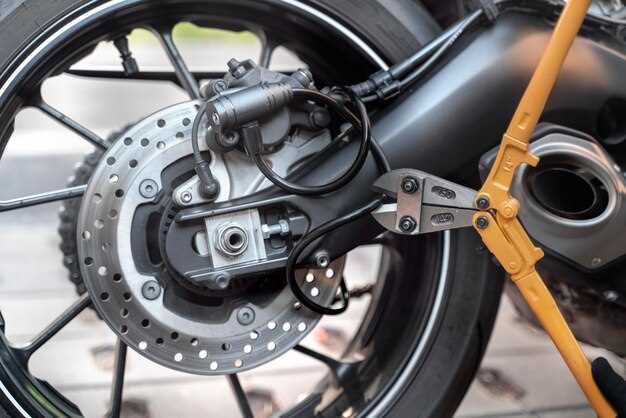
Achieving optimal balance in motorcycle wheels is crucial for any racer seeking to enhance performance on the track. The precision with which wheels are balanced can significantly impact handling, stability, and overall lap times. A motorcycle with unbalanced wheels can experience vibrations, reduced traction, and unpredictable behavior, making it imperative to address this aspect before hitting the race course.
Understanding the dynamics of wheel balance involves a combination of technique and equipment. This process ensures that weight is evenly distributed around the wheel, minimizing discrepancies that can lead to performance problems. Racing demands the highest level of precision, as even the slightest imbalance can hinder a rider’s ability to navigate tight corners at high speeds seamlessly.
In this article, we will explore effective methods for balancing motorcycle wheels, helping you achieve the necessary precision for optimal performance. From the tools needed to professional techniques, our guide aims to equip racers with the knowledge required to fine-tune their machines, ensuring they can achieve their best on the racetrack.
Understanding the Importance of Wheel Balance in Racing

Wheel balance plays a crucial role in achieving precision during racing. When motorcycle wheels are not balanced correctly, it can lead to uneven wear, handling issues, and reduced performance on the track. An unbalanced wheel causes vibrations that can distract riders and impede their ability to feel the road, compromising their control over the motorcycle.
In high-speed racing scenarios, every detail matters. A balanced wheel ensures that the weight is evenly distributed around the axle, resulting in a smoother ride and enhanced tire contact with the surface. This consistency is vital for maintaining grip and stability, allowing riders to execute sharp turns and rapid acceleration confidently.
Moreover, proper wheel balance reduces the strain on suspension components and tires, promoting longevity and reliable performance. By minimizing mechanical fatigue, racers can focus on their technique rather than dealing with potential hazards associated with an imbalanced setup.
In summary, wheel balance is not just a technical detail; it is a fundamental aspect that directly impacts the overall racing experience. Competitors striving for higher levels of precision must prioritize proper balancing techniques to achieve optimal performance on the track.
Step-by-Step Guide to Achieving Perfect Wheel Balance
Achieving perfect wheel balance is essential for racing precision and optimal performance. Follow these steps to ensure your motorcycle wheels are balanced accurately.
1. Gather Necessary Tools: You will need a wheel balancer, weights, mounting tape, and a marker. Ensure the balancer is set up on a level surface for accurate results.
2. Remove the Wheel: Start by carefully removing the wheel from the motorcycle. Follow your manufacturer’s instructions to avoid damage to the bike.
3. Clean the Wheel: Use a cloth to clean the wheel rim thoroughly. Removing dirt and debris ensures the weights adhere properly for precise balance.
4. Mount the Wheel on the Balancer: Place the wheel onto the balancer, ensuring it is properly centered. Spin the wheel gently to identify any heavy spots that cause it to stop at a specific position.
5. Mark Heavy Spots: As the wheel spins, take note of where it stops. Use a marker to indicate the bottom point, which shows where added weight is needed for balance.
6. Add Weights: Start with small weights and attach them opposite to the marked heavy spot on the rim. This helps counteract the imbalance. Make sure the weights are securely fastened to avoid them falling off during use.
7. Recheck Balance: Spin the wheel again to see if it stays in a neutral position. If it does not, continue adjusting the weight until the wheel can stop in any position without falling to one side.
8. Final Adjustments: Make fine adjustments by adding or removing weights as necessary. Ensure the wheel has perfect balance before proceeding.
9. Replace the Wheel: Once balance is achieved, mount the wheel back on the motorcycle following safety protocols.
10. Test Ride: Take your motorcycle for a short test ride to ensure that the wheel balance is maintained under real conditions. Pay attention to handling and vibration, adjusting weights if necessary.
By following these steps diligently, you can achieve perfect wheel balance, which is crucial for racing precision and performance.
Troubleshooting Common Wheel Balancing Issues

Balancing motorcycle wheels is crucial for achieving optimal performance, especially in racing scenarios. However, even after balancing, riders may experience certain issues. Here are some common problems you may encounter and how to address them.
1. Vibration at High Speeds
If you notice a vibration while riding at higher speeds, it usually indicates an imbalance in the wheel. First, check if the weights used for balancing are securely attached. If the weights are missing or improperly placed, rebalancing the wheel is necessary. Additionally, inspect the tire for any deformities, as irregularities can affect balance.
2. Uneven Tire Wear
Uneven tire wear can be a sign of improper balance. Over time, this may lead to significant performance issues. Examine the entire tire surface for signs of uneven wear patterns. If the tire is consistently wearing on one side, consider rebalancing the wheel or seeking professional assistance to check alignment and suspension settings.
3. Noise from the Wheel
Unusual noises coming from the wheel area during rides could indicate a balancing issue. Listen for sounds like thumping or grinding, which may suggest that the wheel is not suitably balanced or that there are faulty bearings. Inspect components closely and, if needed, rebalance the wheel and check for any damaged parts.
4. Difficulty Steering
Difficulty in steering or a tendency for the motorcycle to pull to one side can also stem from wheel imbalance. Ensure that both wheels are balanced equally. If the rear wheel is more heavily weighted than the front, it can affect handling. Reassess your balancing job and make necessary adjustments.
5. Front-End Shimmies
Experiencing front-end shimmies, particularly when decelerating, often points to a wheel balance issue. In this case, recheck the front wheel for proper weight distribution. Using a dynamic balancing method may help pinpoint problems that static methods cannot identify.
By closely monitoring these common issues and addressing them promptly, riders can ensure that their motorcycle wheels maintain proper balance, contributing to enhanced performance and safety on the track.
